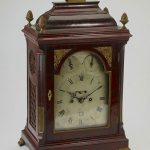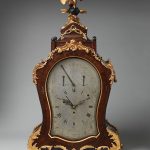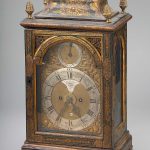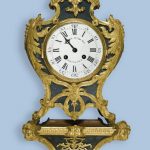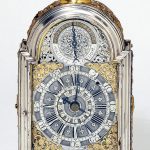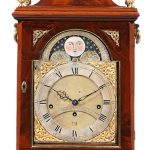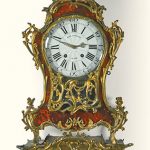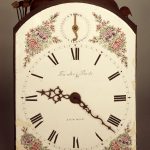Below are some examples, information, history and price guides to 18th century bracket clocks including a musical bracket clock with calendar and a George III bracket clock by Norton.
George III mahogany and brass bracket clock, ca. 1780, having a handle finial over an ogee shaped top surmounting a case fitted two glazed doors, the front opening to an arched white enamel clock face with black Roman numeral markers, and the back opening to the foliate chased brass back plate and pendulum, having pierced side panels covered with red fabric, the whole rising on ogee bracket feet, face marked ‘C. Miles London,’ 21.25″h x 12.75″w x 8.5″d.
Sold for $2,250 at Great Gatsby’s Auction Gallery, Inc. in 2019
Musical bracket clock with calendar ca. 1770 or later Clockmaker: Thomas Lozano A native of Spain, Lozano learned his craft in London and spent his working life there, hence the London place-name and Spanish spelling on the dial of this clock. The case, dial, and back plate of the clock all reflect the influence of English rococo style but are not typically English. The movement incorporates a musical mechanism, with a choice of twelve tunes, which like the striking mechanism can be silenced at will.
Reference: The Metropolitan Museum of Art
Bracket Clock Edward Wicksteed (English, born 1732, working in London 1763–1811) English (London) about 1768
Dark green and gilded japanned case on block feet. Rectangular door with arched panel and carving in upper corners. Domed top with bail handles, brass pineapples on corners. Glass panels on sides. Silver and brass dial with applied ornaments in corners and around Silent and Strike medallion in arch.
Reference: Museum of Fine Arts Boston
A LOUIS XV GILT BRONZE-MOUNTED BLUE-STAINED HORN BRACKET CLOCK, CIRCA 1730 the dial signed Causard Hger. Du Roy Suivt. La Cour; the Napoleon III movement by Japy Frères, stamped JAPY FRERES & CIE EXPOSITION 1855 GRANDE MED. D’HONNEUR and numbered 4-8 and 459 height 27 in.; width 11 in.; depth 7 in. 68.5 cm; 28 cm; 18 cm
Sold for 6,250 USD at Sotheby’s in 2019
Bracket Clock – Paulet
Small clocks such as this example are thought to have been used when travelling. Too large to be used in a carriage, they were designed to be carried from place to place. It has been suggested that they might well have been used on board ship, fitted into a case fixed to the wall of a cabin.
Little is known about the maker who signed himself ‘Paulet’. A number of clocks with his signature are recorded and he seems to have had wealthy clients. A clock by him in the Metropolitan Museum, New York bears the royal monogram of Queen Anne (ruled 1702-1714). The distinctly Continental style of his clocks and his French name suggest that he was a Huguenot (French Protestant emigré).
The clock strikes hours in passing and repeats the hours and quarters. The central dial at the front is used to set the alarm, and the pointer on the top dial is for the calendar. The clock was not an eight-day clock; it had to be wound more frequently. The gilt-brass decoration on the sides of the case owes much to the influence of Daniel Marot (1663-1752), a French architect and printmaker active in The Netherlands, whose designs were very fashionable in England when this clock was made.
Reference: © Victoria and Albert Museum
A GEORGE III MAHOGANY AND GILT METAL MOUNTED QUARTER STRIKING BRACKET CLOCK The dial signed Norton, London The case with a pagoda top and five pine cone finials over a moulded cornice, the front door framed in lacquered brass fillets, on a moulded base and brass foliate scroll feet, the 7.5 inch dial with date aperture within foliate spandrels, surmounted by a moon phase, the side apertures of pierced panels with classical motifs, the movement striking on a rack of bells, the back plate engraved with scrolling acanthus leaves, 33cm wide, 21cm deep, 56cm high (12 1/2in wide, 8in deep, 22in high)
Sold for £ 3,562 inc. premium at Bonham’s in 2019
